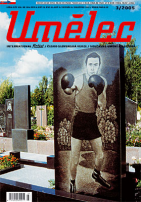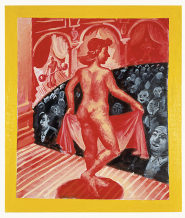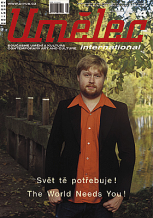| Umělec 2005/3 >> Cyril Blažo - Double Exposition of sketches | Просмотр всех номеров | ||||||||||||
|
|||||||||||||
Cyril Blažo - Double Exposition of sketchesUmělec 2005/301.03.2005 Vlado Beskyd | profile | en cs de es |
|||||||||||||
|
Among young artists with a post-conceptual orientation emerging on the Slovak scene during the last decade is Cyril Blažo, born in Bratislava, 1970. He alters the coding of old signs, rendering them abstruse and setting them free. During his studies (VŠVU Bratislava 1988-94) Blažo founded Blondiak (Blond Guy), a loose grouping in collaboration with Boris Ondreička and Stano Dančiak Jr., where they’d toss ideas, gags and word games at each other like hot potatoes (exhibitions in Bratislava in 1991, 1994, 1996). A series of invitations to exhibition projects at home and abroad followed. 1
With wit and irony, Blažo communicates curtly using unique imagery; his sketches—short scenes and fleeting aberrations—function as hairpin triggers to set off explosions. Establishing ambivalent, banal and absurd situations, he transgresses traditional media boundaries to blur distinctions of original and copy. Often the artist exploits illustrations and reproductions from old books and magazines to profit from old imagery removed from time. He extracts a blend from this collection: art aphorisms, impertinent comments, and naive suggestive comic sketches where free play, detachment and quirky humor prevail. In this post-production format, the moments in which visual signs are selected and then articulated anew are of great importance as they lead to new articulations, along with double coding and paradoxical use of gaps in the cultural context. Working with his hands in his pockets, he tackles things with a broad disarming smile and a phlegmatic aside: “Well, you know how.” He arrives at simple solutions, such as with his Columbus’ Egg. Settled in his prefab cave, he developed a prank entitled Kingdom of Lazing – something between Bruegel and Malevich’s Praise of Idleness. He applies a solid alco-holistic approach. The collection of drawings, photocopies, photo-collages, and prints that he has accumulated over the years is small enough such that the retrospective can easily fit into a single presentation. Some of his works are the mere appropriation of a model with no intervention beyond its transportation into a different context. For such works, small visual “shocks” pop up that slam you right on the head: A presentation of a clean sheet of paper in Ceiling (1999), clumsy writing, notes and pasted photographs from found letters and diaries (Ján Mistrík, E. Vítek, 1997; Actors and Singers, 1999; Notebooks of an Unknown Girl, 2004), unclear black-and-white photographs (Untitled (Armor / Pins and Needles); Untitled (Through Glass), both 1994). The climax of this group is Picture Gallery (2003), a series of color photographs incorporating cut-outs of pictures of Internet photographic pornography hung on the walls. In this way, both famous works and kitschy landscapes conceal details of alluring bodies; that which is revealed folds into realms concealed. Another category of works involves some direct intervention by the artist with a collage of two or more layers. Cyril Blažo reaps what he hasn’t sown, but intervened. He inhales anything from the visual archives and with slight interventions or adjustments, or more precisely by assigning distinctive titles, he breaths out new contents, opening new stories and fragments. In Holiday (1994), there are emptied cupboards and drawers; the upturning of a hill by 90 degrees reveals the profile of a face in Kriváň (Profile 1, 2002); He Who Has the Yellows, Sees Everything Yellow (2003) is simply transparent yellow film over wallpaper fluttering in a light breeze; a highlighted photograph of a rotund face is presented with the eyes swapped in Lucifer, (2002). Blažo prefers unresolved stories and situations. These indifferent and ambiguous takes create space for characteristically diffused double visions and readings. Sparkling micro-stories and weird meetings of different kinds come to life: the Dadaistic encounter in Goat and Cross, (1999), the double exposure of a molar and a stool in Stool (1992), a little man falling out of a postage stamp in A Trip with Suicide (2000), or the sun confronted with ordinary scenes from public swimming pools and the fall of Icarus in The Fall (1999). It is also the disruption of various conventions and taboos, sometimes with black humor: women’s heads with their muddy faces impaled on wooden stakes with blood flowing down in All At Once (1999); two figures of headless soccer players kicking a head as a ball are featured in A Game with a Black Head, (2003); in J (2002), the Slovak Robin Hood, Jánošík, is pinned on a fish hook in front of the face of a toothless fish as live bait; perhaps because we have other Jánošíks to fry. Yet another group of Blažo’s works consists of his own drawings and commentaries. A series of small drawings are crude figural compositions in his Sketchbook (1991-93), a couple of drunken bears in a friendly embrace with a real hip flask of rum on magnificent golden paper is depicted in Friends (1999). For the Czech-Slovak exhibition he prepared two mascots of Czech and Slovak evening children’s TV programs having sex during a broadcast of a children’s program in Evening; Evening 2 , 7 p.m. (2003). We also notice a couple of versions of Work: a woman setting bricks on a pile of humus in Work 2 (1994), the popular figure of a gravedigger with a shovel Work (1999). Digging wells and graves has its own poetry and a profound sacred dimension. Nevertheless, Cyril Blažo still searches where the shoe pinches – and that is a “hell of a job.”Alongside such light-hearted commentaries some existential questions also appear, a small private blues (or a fatal dose of optimism) is presented with the vulnerable points in a human body marked, in Lethal Points in a Person (1996), a round collage of rotting fruit in Still Life (1999), a skeleton hand with some juicy fruit in Still Life 2 (1999), or the lonely streaming Black Flag (2002). Blažo thus continues creating non-artistic forms of current thinking by overlapping visual layers and meanings. By an ironic gesture, he changes the motto of cleaners and modernists so that “keep things clean” becomes “keep things unclean.” Indeed, that has stuck to him so far (in his paintings and on his shoes). 1 (Zwischen Objekt und Installation, Museum am Ostwald Dortmund 1992; Blue Fire (3rd Biennial of Young Art), Dům U Kamenného Zvonu (The House at the Stone Bell), Prague, 1999; Slovak Art for Free, Czecho-Slovak pavilion, the 48th Venice Biennale 1999; Young Flesh – (not)bad blood, Gallery Sokolská 26 Ostrava 2000; Czechoslovakia, SNM Bratislava 2003; Hot Destination /Marginal Destiny II, DUMB (The Brno House of Art), 2004; Check Slovakia!, Neuer Berliner Kunstverein Berlin 2004).
01.03.2005
Рекомендуемые статьи
|
|||||||||||||
|
04.02.2020 10:17
Letošní 50. ročník Art Basel přilákal celkem 93 000 návštěvníků a sběratelů z 80 zemí světa. 290 prémiových galerií představilo umělecká díla od počátku 20. století až po současnost. Hlavní sektor přehlídky, tradičně v prvním patře výstavního prostoru, představil 232 předních galerií z celého světa nabízející umění nejvyšší kvality. Veletrh ukázal vzestupný trend prodeje prostřednictvím galerií jak soukromým sbírkám, tak i institucím. Kromě hlavního veletrhu stály za návštěvu i ty přidružené: Volta, Liste a Photo Basel, k tomu doprovodné programy a výstavy v místních institucích, které kvalitou daleko přesahují hranice města tj. Kunsthalle Basel, Kunstmuseum, Tinguely muzeum nebo Fondation Beyeler.
|






































 New book by I.M.Jirous in English at our online bookshop.
New book by I.M.Jirous in English at our online bookshop.
Комментарии
Статья не была прокомментированаДобавить новый комментарий